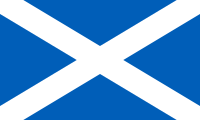Flag of Scotland
| Flag of Scotland | |
|---|---|
 |
|
| Vexillological symbol : |
|
| Aspect ratio: | 3: 5 |
| Officially accepted: | 16th Century |
The flag Scotland consists of a white Andrew's Cross (engl. Saltire ) on a light blue background. A rarely used version has a dark blue background. A flag, which is not officially approved for the population but is still frequently used, shows a red soaring lion on a yellow background , surrounded by "lily double bars". This is the Scottish royal flag ("Lion Rampant").
The Scottish flag is one of the oldest flags in the world, dating back to the 9th century. Tradition tells that in the year 832 a King Hungus (or Angus) is said to have led the Picts and Scots into a battle against the Anglo-Saxons . Hungus and his soldiers were surrounded and he prayed for redemption. During the night the apostle Andrew (who had been crucified on a diagonal cross) appeared and assured Hungus that his army would be victorious. At dawn the clouds in the blue sky took on the shape of a diagonal cross. The Picts and Scots were encouraged, while the Anglo-Saxons were terrified and eventually defeated. The St. Andrew's Cross has been the flag of Scotland ever since. The saint's relics were later brought to Scotland and what became known as St Andrews .
There is no exact official definition for the shade of blue. The blue used varied over the centuries, ranging from a light sky blue to a dark navy blue. According to a joke, the choice of color was based on which shade of blue was currently available at the cheapest price. Lately, however, there seems to have been an agreement on the Pantone 300 shade . No matter which shade is used, it must always be lighter than the one on the Union Jack . The size ratio is also not officially set, but is generally given as 3: 5 or 2: 3 (a longer version is preferred, that would be the former - British flags are usually 1: 2, so even longer than wide); 4: 5 can also be found in the literature. The width of the cross bars should be a fifth of the flag height.
Other flags with St. Andrew's cross
The Scottish saltire is one of the components of the Union Jack . The reverse version (blue St. Andrew's cross on a white field) is used as the flag of the Russian Navy . The Scottish Saltire is also found on the coat of arms and flag of the Canadian province of Nova Scotia . The shade used in Nova Scotia is usually light blue.
The flag of Tenerife is similar to the flag of Scotland. The signal flag M in the flag alphabet is also similar to the Scottish flag.
The flag of the Scottish King ("Lion Rampant")
Since 1332 at the latest, the coat of arms and the flag of the Scottish kings show a red soaring lion (Lion rampant) on a golden background, surrounded by double red lily bars.
The lion was already adopted in the early 13th century by William I , who was also called "William the Lion", and can be identified as a heraldic animal for the first time in 1222 in the seal of his son Alexander II .
This coat of arms was integrated into the coat of arms of the United Kingdom at the beginning of the Anglo-Scottish personal union in 1603 and has since been seen on the royal flag of the United Kingdom.
The use of the flag with the soaring lion, of the Royal Standard of Scotland, is reserved for monarchs. She is officially raised in the Scottish Royal Residences at Holyrood Palace and Balmoral Castle when the Queen is absent. If she is present, however, the Scottish version of the UK's Royal Standard is hoisted. The Queen's representatives, including the First Minister of Scotland , the Lord Lieutenants , the Lord High Commissioner to the General Assembly of the Church of Scotland and the Lord Lyon King of Arms , are also allowed to run the Royal Standard of Scotland . As the Queen's personal banner, the flag is used under the Parliament of Scotland Act of 1672, cap. 47 and 30 & 31 Vict. cap. 17 protected. Nevertheless, it is so popular as an alternative flag for Scotland (e.g. for international football matches) that it would be politically impossible to prosecute someone for it.
In addition to the flag of the king, the rising lion also appears in the flag of the Duke of Rothesay , the eldest son of the respective monarchs (today: Prince Charles ).
See also
- Union Jack , the national flag of the United Kingdom of Great Britain and Northern Ireland
- Flag of England , the Saint George Cross
- Flag of Nova Scotia (Nova Scotia), a Canadian province
- Coat of arms of Scotland
Web links
Individual evidence
- ^ The New Encyclopedia Britannica, 15th Ed., 1993, Vol. 10, p. 310.
- ↑ Scotland: legalities of flag
